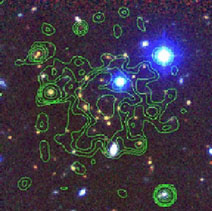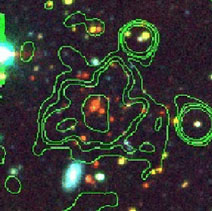Copyright © 2002 by Annual Reviews. All rights reserved
| Annu. Rev. Astron. Astrophys. 2002. 40:
539-577 Copyright © 2002 by Annual Reviews. All rights reserved |
4.3. Distant X-ray Clusters: the Latest View from Chandra
With its unprecedented angular resolution, the Chandra satellite has revolutionized X-ray astronomy, allowing studies with the same level of spatial details as in optical astronomy. Chandra imaging of low redshift clusters has revealed a complex thermodynamical structure of the ICM down to kiloparsec scales (e.g. Markevitch et al. 2000, Fabian et al. 2000). At high redshifts, deep Chandra images still have the ability to resolve cluster cores and to map ICM morphologies at scales below 100 kpc. Moreover, temperatures of major subclumps can be measured for the first time at z > 0.6.
Figure 10 is an illustrative example of the unprecedented view that Chandra can offer on distant clusters. We show twelve archival images of clusters at 0.7 < z < 1.7 all covering 2 Mpc (projected at the cluster redshift) and smoothed at the same physical scale (a Gaussian FWHM of 70 kpc). Point-like sources in each field were removed. The intensity (in false colors) is proportional to the square root of the X-ray emission, so that they roughly map the gas density distribution in each cluster. The images are arranged in three redshift bins (~ 0.7, 0.8, > 1), in each row, with X-ray luminosities increasing from left to right. The upper left image shows one of the highest redshift groups known to date, a system discovered in the megasecond exposure of the Chandra Deep Field South (Giacconi et al. 2002) with a core of a few arcseconds. A close inspection of these images reveal a deviation from spherical symmetry in all systems. Some of them are elongated or have cores clearly displaced with respect to the external diffuse envelope (e.g. Holden et al. 2002).
Three of the most luminous clusters at
z  0.8 (RXJ1716>:
Gioia et al. 1999;
RXJ0152:
Della Ceca et al. 2000,
Ebeling et al. 2000a;
MS1054:
Jeltema et al. 2001)
show a double core structure both in the
distribution of the gas and in their member galaxies. It is tempting
to interpret these morphologies as the result of on-going mergers,
although no dynamical information has been gathered to date to support
this scenario. In a hierarchical cold dark matter formation scenario,
one does expect the most massive clusters at high redshift to be
accreting subclumps of comparable masses, and the level of
substructure to increase at high redshifts. With current statistical
samples however, it is difficult to draw any robust conclusion on the
evolution of ICM substructure, which is also found to be a large
fraction of the low-z cluster population (e.g.
Schücker et
al. 2001b).
0.8 (RXJ1716>:
Gioia et al. 1999;
RXJ0152:
Della Ceca et al. 2000,
Ebeling et al. 2000a;
MS1054:
Jeltema et al. 2001)
show a double core structure both in the
distribution of the gas and in their member galaxies. It is tempting
to interpret these morphologies as the result of on-going mergers,
although no dynamical information has been gathered to date to support
this scenario. In a hierarchical cold dark matter formation scenario,
one does expect the most massive clusters at high redshift to be
accreting subclumps of comparable masses, and the level of
substructure to increase at high redshifts. With current statistical
samples however, it is difficult to draw any robust conclusion on the
evolution of ICM substructure, which is also found to be a large
fraction of the low-z cluster population (e.g.
Schücker et
al. 2001b).
The third row in Figure 10 show the most distant
clusters observed with Chandra to date. The first three systems
are also among the most distant X-ray selected clusters discovered in
the ROSAT Deep Cluster Survey
(Stanford et al. 2001,
2002),
at the very limit of the ROSAT sensitivity.
RXJ0848 and RXJ0849
are only 5 arcmin apart on the sky (the Lynx field) and are possibly
part of a superstructure at z = 1.26, consisting of two collapsed,
likely virialized clusters
(Rosati et al. 1999).
Follow-up Chandra observations of the Lynx field
(Stanford et al. 2001)
have yielded for the first time information on ICM morphologies in z
> 1 clusters and allowed a measurement of their temperatures (see
Figure 14 below), implying masses of
(0.5 - 1) × 1015 h50-1
M . The
discovery and the study of these remote systems have the strongest
leverage on testing cosmological models.
. The
discovery and the study of these remote systems have the strongest
leverage on testing cosmological models.
In Figure 11, we show color composite optical/near-IR images of two clusters at z > 1, with overlaid Chandra contours. Already at these large lookback times, the temperature and surface brightness profiles of these systems are similar to those of low redshift clusters. Moreover, the morphology of the gas, as traced by the X-ray emission, is well correlated with the spatial distribution of member galaxies, similar to studies at lower redshifts. This suggests that there are already at z > 1 galaxy clusters in an advanced dynamical stage of their formation, in which all the baryons (gas and galaxies) have had enough time to thermalize in the cluster potential well. Another example of a z > 1 cluster was reported by Hashimoto et al. (2002) using XMM observations of the Lockman Hole.
 |
 |
Figure 11. Color composite images
combining optical and near-IR imaging
of two X-ray selected clusters at z > 1. Overlaid contours
map the X-ray mission detected by Chandra/ACIS-I. (Left)
RXJ0910+5422 at z = 1.11
(Stanford et al. 2002);
(right) RXJ0849+4452 at z = 1.26
(Rosati et al. 1999,
Stanford et al 2001).
The two fields are 1.5 arcmin across
( |
|
At z > 1.3, X-ray selection has not yielded any cluster based on ROSAT data. Follow-up X-ray observations of distant radio galaxies have been used to search for diffuse hot ICM (e.g. Crawford & Fabian 1996). A relatively short Chandra observation of the radio galaxy 3C294 at z = 1.789 (bottom right in Figure 10) (Fabian et al. 2001b) has revealed an extended envelope around the central point source, which is the most distant ICM detected so far. Deeper observations are needed to accurately measure the temperature of this system.